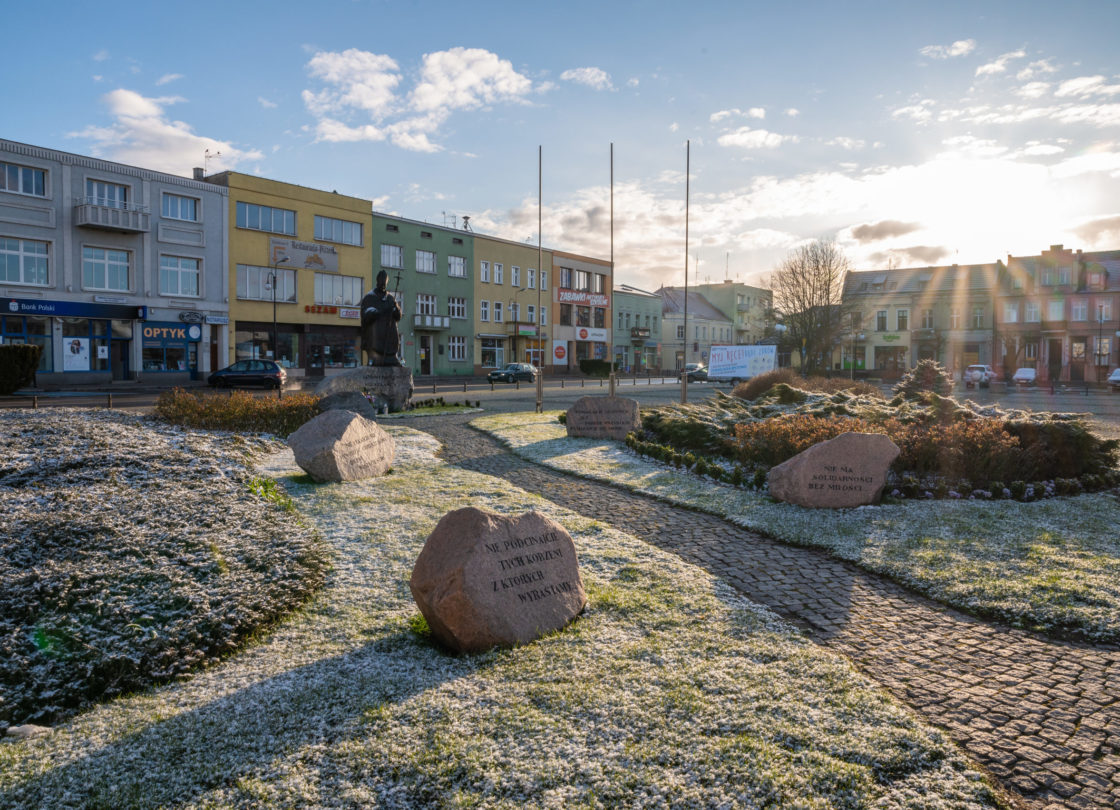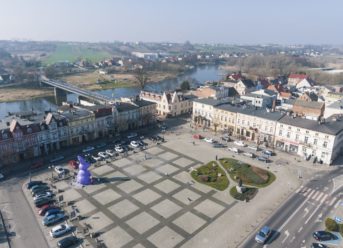Rynek
Der Marktplatz
The Town Square
Wytyczony w średniowieczu układ urbanistyczny Obornik z rynkiem i odchodzącymi od niego turbinowo, po dwie z każdego narożnika ulicami. Rynek utworzono w miejscu placu targowego. Z planu miasta po 1438 roku wynika, że na zewnątrz placu targowego mógł znajdować się Ratusz. Od Rynku odchodzi szachownica ulic: główne prowadzą do Czarnkowa i Obrzycka, do Murowanej Gośliny i Szamotuł. Układ urbanistyczny Obornik został w 1956 roku wpisany do rejestru zabytków, co podkreśla jego unikatowość i niepowtarzalność.
Z dawnej zabudowy Rynku i przyległych ulic, na uwagę zasługują kamienice klasycystyczne i secesyjne z XIX i początku XX wieku, z ciekawą dekoracją elewacji frontowych i częściowo zachowanym attykami. W centralnym punkcie znajduje się wykonany w 2005 roku pomnik Jana Pawła II, autorstwa Roberta Sobocińskiego. Również na Rynku mieści się: kamienna fontanna i stylowa pompa, ta ostatnia w pobliżu dawnej studni artezyjskiej.
Der rechteckige Marktplatz - das urbane Zentrum von Oborniki - wurde im Mittelalter angelegt. Am Markt münden acht Straßen, je zwei an allen Ecken. Der heutige Marktplatz entstand an der Stelle des vorherigen Hauptplatzes, auf dem es gegenwärtig gehandelt wurde. Der aus dem Jahre 1438 stammende Stadtplan weist auf, dass am Rande des mittelalterlichen Hauptplatzes ein Rathaus stehen konnte. Vom Marktplatz gehen die Straßen unter dem rechteckigen Winkel ab: die Hauptstraßen in die Richtungen Czarnków, Obrzycko, Murowana Goślina und Szamotuły. Die städtebauliche Gliederung der Stadt steht unter Denkmalschutz, was ihre Außergewöhnlichkeit beweist.
Von den alten Marktgebäuden blieben klassizistische und im Jugendstil erbaute Bürgerhäuser aus dem 19. Jh. und aus dem Anfang des 20. Jhs. erhalten. Beachtenswert sind vor allem ihre verzierte Fassaden und zum Teil erhaltene Attikas. Im zentralen Punkt des Platzes befindet sich das Denkmal für Papst Johannes Paul II., von Robert Sałaciński entworfen. Auf dem Marktplatz gibt es auch einen Steinbrunnen und eine schöne Pumpe, die in der Nähe von dem vorherigen artesischen Brunnen errichtet wurde.
Urban planning arrangement of Oborniki was marked out in the Middle Ages with the market in the center and two streets diverging from every corner at a 90 dagrees angle to eachother. The Town Square was created in the place of an old marketplace. According to the town plan, after 1438 the town hall could have been located outside the old marketplace. A chessboard of streets is diverging from the Town Square with the main ones leading to Czarnków, Obrzycko, Murowana Goślina and Szamotuły. The urban planning arrangement of Oborniki was entered in a register of monuments in 1956 emphasizing its uniqueness.
From the old buildings of the Town Square and adjacent streets its worth noting the classical and Art Nouveau tenements from 19th and beginning of the 20th century, with the interesting decoration of the front elevations and partly kept Attics. In the central point of the squere there is a monument to John Paul II, created in 2005 by Robert Sobociński. There is also a stone fountain and a stylish pump, located near the former Artesian well.






